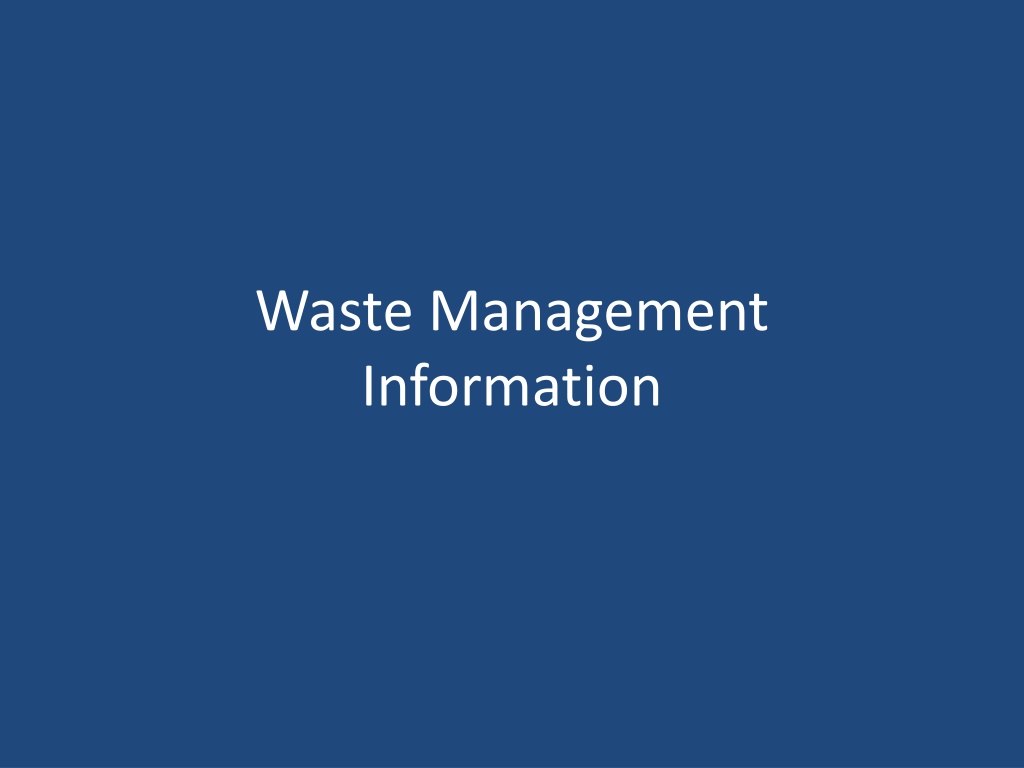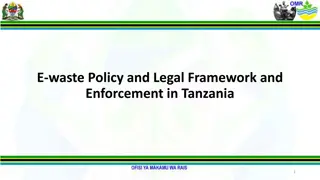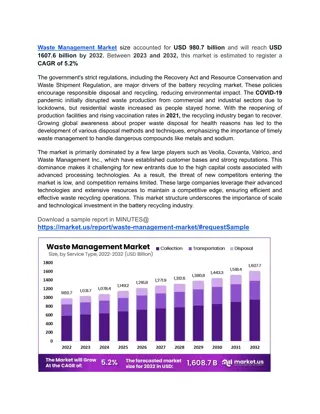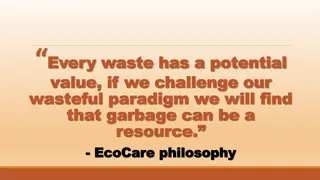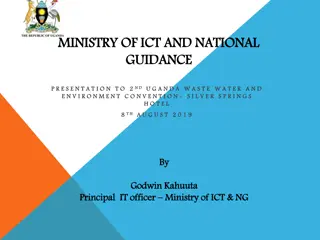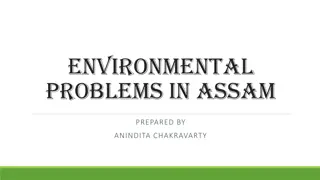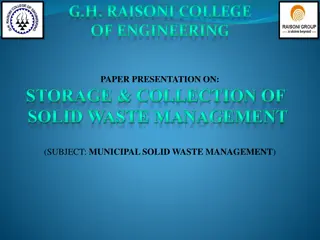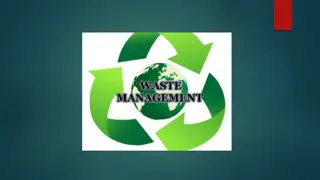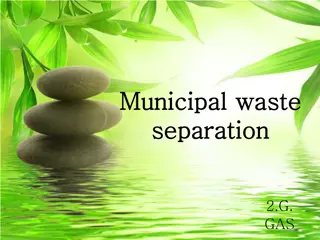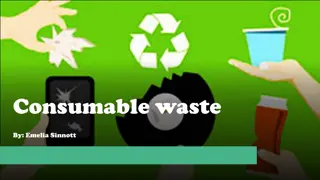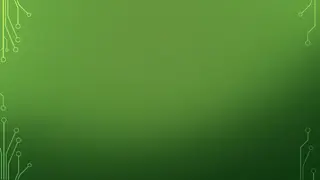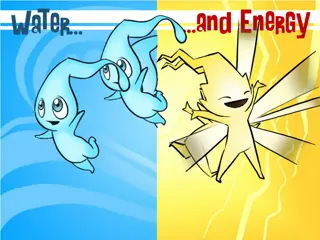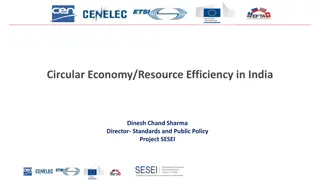Environmental Impact of Dangerous Waste Management
Explore the history and regulations surrounding dangerous waste management, the risks posed by improper disposal, and the importance of identifying and handling hazardous materials. Learn about specific products of concern and the environmental consequences of mishandling chemical wastes.
Download Presentation

Please find below an Image/Link to download the presentation.
The content on the website is provided AS IS for your information and personal use only. It may not be sold, licensed, or shared on other websites without obtaining consent from the author. Download presentation by click this link. If you encounter any issues during the download, it is possible that the publisher has removed the file from their server.
E N D
Presentation Transcript
Waste Management Information
Dangerous Waste Chemical wastes including federally regulated Hazardous Waste Regulatory Information WAC 173-303 Washington s dangerous waste regulations most protective in the nation
Why Does It Matter Storm drains discharge directly into local lakes, streams, and rivers Wastewater treatment plants are not designed to remove chemicals Laboratory chemicals and commercial products can pass through the treatment process and into the environment Certain chemicals can upset the wastewater treatment process and result in raw sewage dumping into the environment Landfills can leak organic liquids and heavy metals into groundwater
The Past Cuyahoga River - 1969
Timeline 1883 First large chemical fire on the Cuyahoga River 1948 Federal Water Pollution Control Act 1955 Air Pollution Control Act 1963 Clean Air Act (amended 1990) 1965 Solid Waste Disposal Act 1969 National Environmental Policy Act enacted after a large fire on the Cuyahoga River sparks national outcry 1970 Environmental Protection Agency established Earth Day established Washington Department of Ecology established 1972 Clean Water Act 1976 Resource Conservation and Recovery Act 1978 Love Canal makes national news 1980 Comprehensive Environmental Response, Compensation, and Liability Act (Superfund)(Amended and reauthorized, 1986)
Identifying Dangerous Waste Flammable liquids, flash point <60 C/140 F Aqueous alcohol solutions <24% ABV* exempt Oxidizers and peroxides Flammable solids (e.g. metal powders) and explosives Halogenated organic solvents Corrosive liquids and solids (pH 2 or 12.5 ) Pyrophoric and water reactive materials Compressed gasses (all) Heavy metals (Ag, As, Cd, Cr, Hg, Pb, Se) Toxicity Oral rat LD:50 <5,000 mg/kg Fish LC:50 < 10 mg/L Inhalation rat LC:50 <200 mg/L Dermal rabbit LD:50 <20,000 mg/kg Any substance at or above the concentration listed at WAC 173-303-090(8)(c) *ABV = Alcohol by volume
Products of Concern Antiseptics and disinfectants Herbicides, fungicides, nematicides, rodenticides and insecticides Dyes, pigments, glazes, inks, thinners, and paints Etching solutions Commercial cleaners and metal polishing compounds Pyrotechnics, including road flares Drain and oven cleaners
Recycling and Special Wastes Used oil and antifreeze Paint, varnish, and paint related materials (e.g. paint thinner and stripper) Adhesives Spent batteries Spent fluorescent, UV, and metal halide lamps Mercury containing instruments Contact EH&S for assistance with these items. Never discard them in the trash or drain
Other Wastes of Concern BSL-1/2/3 organisms Deactivate or sterilize before discarding Broken glass and sharps Dispose in appropriate containers Human body fluids, body fluid contaminated items, and tissues Animal carcasses and tissue Consult EH&S
Accumulating Dangerous Waste Identify appropriate location(s) Safe from damage or upset Doesn t impede work Readily and unimpeded access Secure when the lab/workspace is unattended Waste Containers Impervious to intended contents Tight fitting cap/lid Undamaged Labeled upon first addition of waste Keep exterior clean Keep tightly capped except when actively adding waste
Waste compatibility and suitability Combine only wastes which will not react with other constituents Leave at least one inch of headspace in containers Do not place solid objects in narrow-mouth vessels Do not place wastes which may cause overpressure in tightly sealed containers Do not combine mercury bearing wastes with any other waste
Removing Waste From Your Work Area Dangerous waste must be removed within three days once the container is filled Consult your departmental representative for instructions Contact EH&S if your department does not have a designated representative
Trash You may discard the following materials in the trash* Sugars, agars, gums, amino acids, and inert solids such as talc, and dry resins and filter media Dry wipes, bench papers and mats, empty containers, unbroken glassware, pipette tips, and weighing papers and boats , dry resins and filter media *No free flowing liquids or items contaminated with Ag, As, Ba, Cd, Cr, Hg, or Se
Drain Disposal You may dispose the following materials in the sink* Aqueous solutions containing buffers and salts (less than 10% by weight) Neutralized inorganic acids and bases (pH 5 9) Blood and other body fluids Flowable aqueous gels, nutrient broths and agars Spent formalin solutions Used neutral pH cleaning solutions and dishwater from glassware cleaning *No Ag, As, Ba, Cd, Cr, Cu, Hg, Se, or Zn
Support Contact Environmental Health and Safety for assistance with Waste collection and disposal Chemical and commercial product safety and environmental information General and workplace safety concerns 527-5966 or ehs@whitman.edu
The Present Cuyahoga River Today
